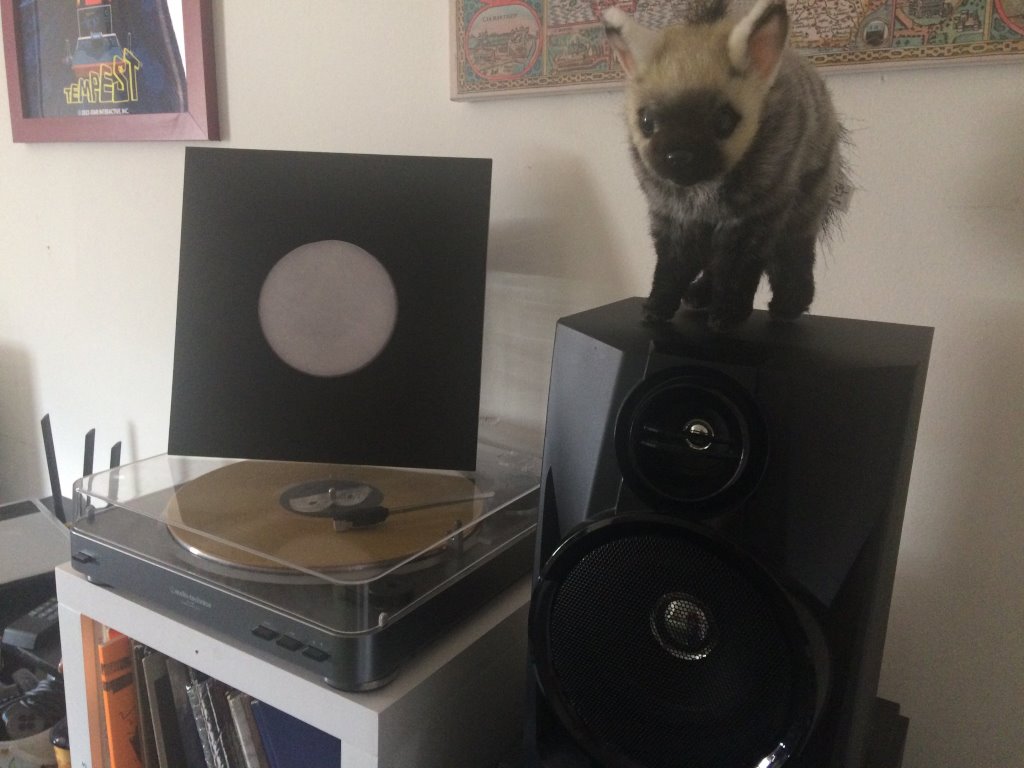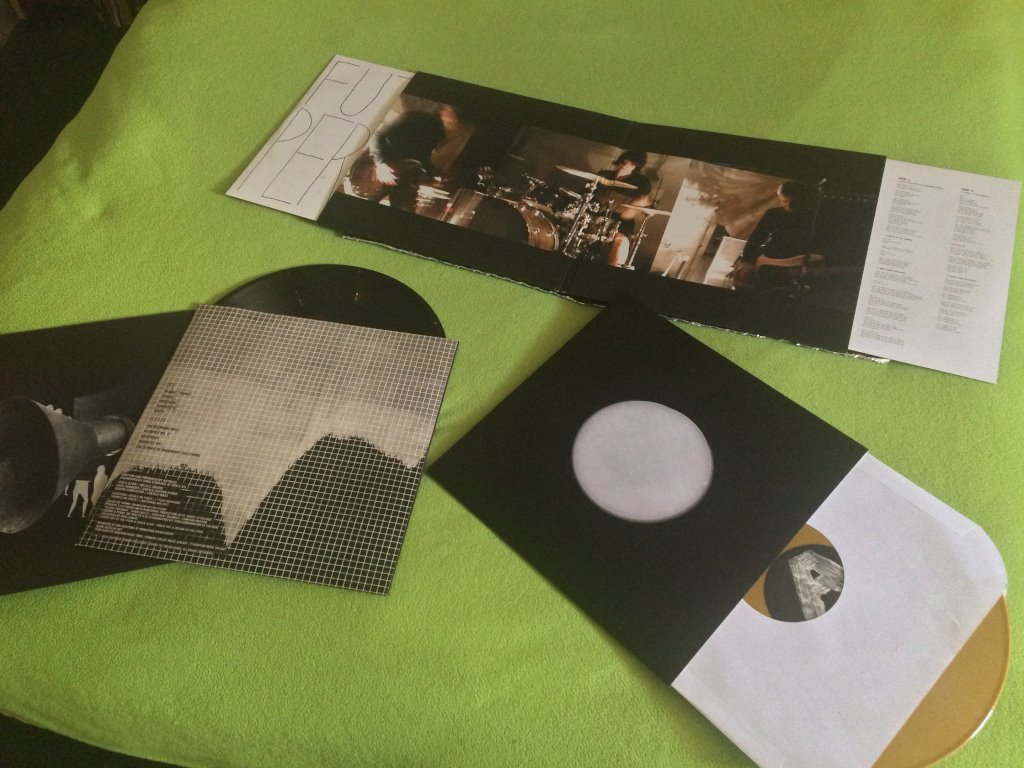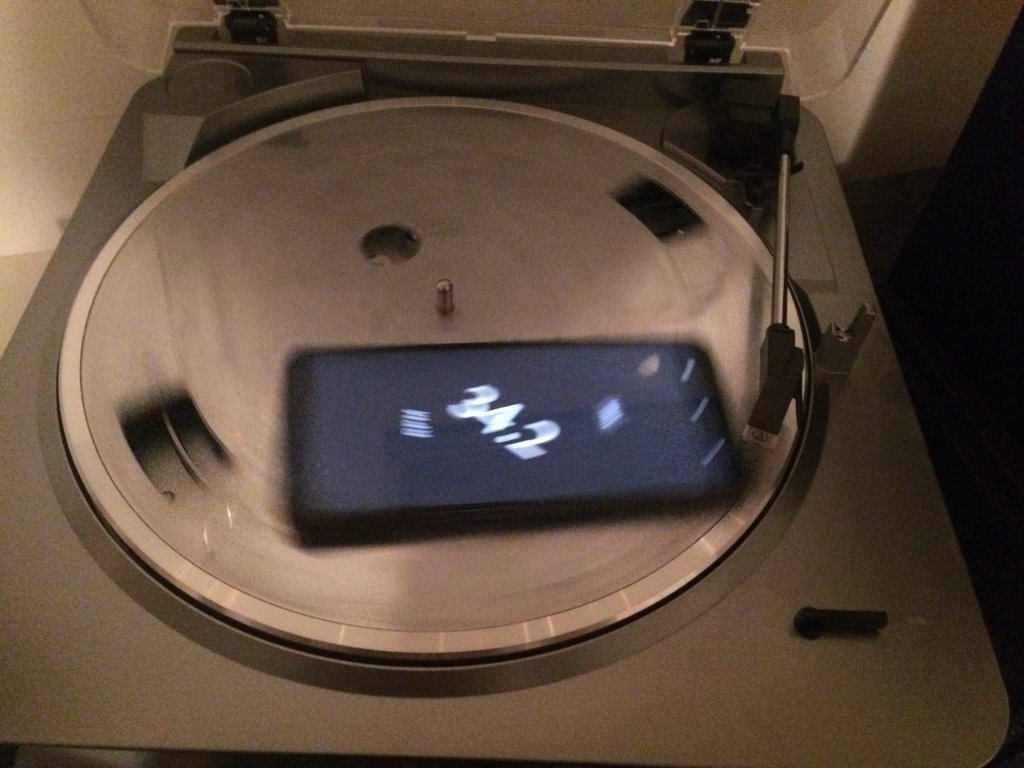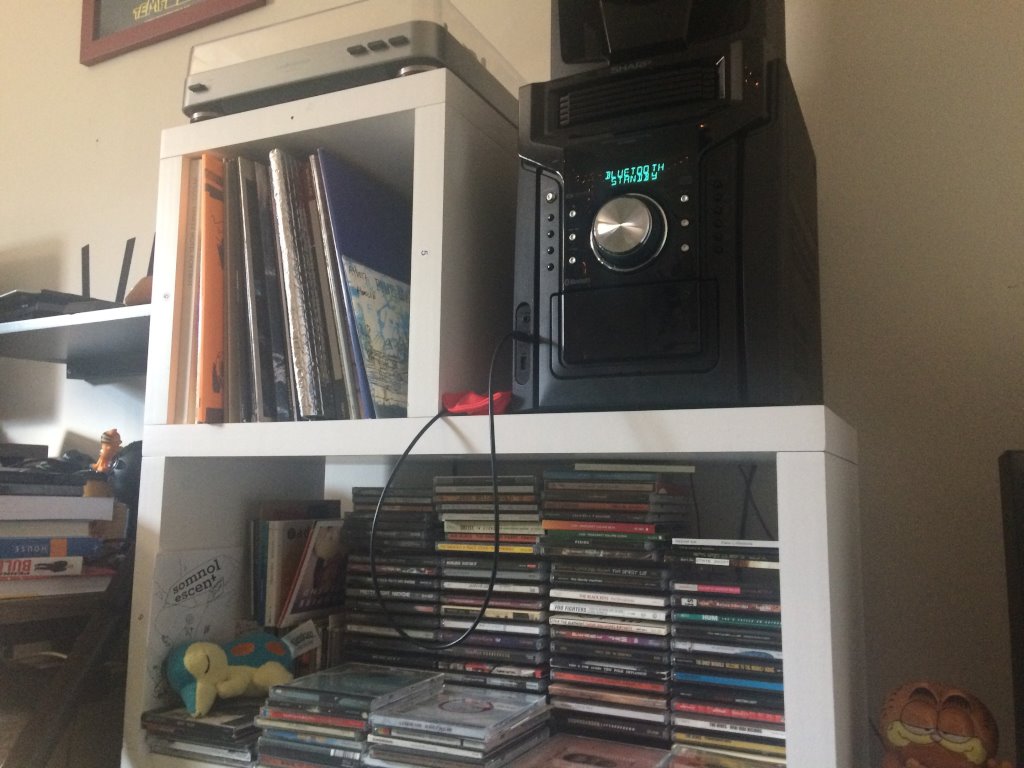I’ve written a lot about music. Like a lot. A lot a lot. Usually, when I talk about music, it’s with this air of formality, either giving my opinion or digging into the details and investigating—I’m autistic, this is what I do.
I do listen to music for fun sometimes, though. I put on songs because they’ve been stuck in my head all day. I have characters and ideas I associate with albums and songs and specific times of my life. Sometimes, even—I will throw on a record.
I’d like to start up a monthly all-vinyl blog ramble series called the Somnolescent Record Club. For once, we’re gonna believe all the myths, get into the groove (quite literally), enjoy the tactility of the big art and the wax platters, and I’ll talk about my listening setup and all the things that run through my head when I put on an album. Today’s record is the vinyl-exclusive gold-colored Demos (2001-2002) from the mighty Autolux, whose debut album these demos were for I lived in in high school.
Hopefully, this runs more casual than you might be used to from me—that’s my aim.
My love-hate relationship with vinyl
I don’t hate vinyl. Actually, I’m quite fuzzy for it. I usually don’t like the mythologizing that vinyl attracts. It’s an old format, so it automatically has the “authenticity” going for it (see also: tube amps). It’s a physical medium where the music is etched into the wax (actually, more like stomped into the wax), which monkey brains like to interpret as a “purer” form of sound than the incomprehensible digital data on a CD or in a FLAC file. There’s a lot of myths about vinyl’s superior sound quality to CD (in every metric, it’s inferior) or its inability to reproduce ultra dynamically compressed digital audio (it can, you just turn the gain down in mastering). One 45 minute album across four sides sucks! You need to spend a few hundred to get the most out of it! I had a teacher in high school declare full-throated that he didn’t understand the Rolling Stones until he heard them on vinyl.
It was all so deliciously mythic, rockist, and snake oil-y. Plus, I was a teenage contrarian. It only makes sense I’d delight in being right.
But really, vinyl is special. Anything that stores music is special! Even though I know the technical limitations and that it’s expensive and that vinyl requires all this maintenance and a decent turntable to get the most out of it, there truly isn’t anything like a record. I dunno, man, it’s imperfect, and that’s kinda awesome. I bought a record for the first time in a long time back in December, and there really is a ritual to it, the Matryoshka packaging of inserts and sleeves, fishing the disc out, putting it on the turntable, cleaning it quick, letting the needle drop, hearing the song emanate quietly and scratchily from the disc itself as the cartridge blasts it into your speakers, that reminded me “oh yeah, I do like vinyl”. Plus, I have plenty of memories of listening to vinyl in high school, all of those discs I still have in my possession to this day.
I find vinyl to be the perfect metaphor for what I want this series of posts to explore. You can’t get rid of the crackle completely, and every single play of the record slowly wears out all the high end until it sounds like you need hearing aids. It’s already messy, imperfect music, reproduced in an inherently failing medium, soundtracking all the tormented creatures that dance around in my neurotic head. I do love it, even with all of its shortcomings, and that’s how I feel about everything in life at this point.
Headless sky
It’s senior picture night in high school. That’s where they ask you to go into a side studio next to the gymnasium (which we’d been using by day as Journalism 1 students to plan a potential school podcast–this was 2016, so before everyone was listening to those), drape you in your oversized graduation gown, and tell you to pose with your hat for a rather expensive momento keepsake for your folks to buy. I believe that photo of me still hangs in our hallway; my hair was a lot shorter, but the style was similar, so the curls awkwardly stuck out along my forehead. Interesting times.
I really was not all that interested in photos, but the thing that continues to astonish me was what the hired gun photographer happened to play as his background music.
I tug my mom’s arm as we wait in line to have photos taken. “Wait, I know that guitar riff.”
It’s the opening to “Headless Sky” by Autolux, a warm, dissonant, repetitive seven hit guitar drone, one that stops awkwardly every two bars to keep you unsettled as Eugene Goreshter comes in with his haunted vocal line. It was never one of my favorite Autolux songs, but to hear not just this obscure, cult favorite L.A. band, but a deep cut off their second record in my rinky-dink backwoods high school, was a trip. I was used to listening to obscure bands with names like The Dandy Warhols and Brad Sucks, bands that had all the adults in my life wondering just what the hell I was listening to–so to have someone else into my music, in the same room as me, separate from me, got me beyond excited.
I worked up the courage to tell the photographer I liked the music he was playing and that I thought Autolux was super cool. “You ever heard of Failure?” he asked me in kind. “Go listen to their third record, it’s called Fantastic Planet. It’s great.”
And that was it. I did listen to Fantastic Planet about a year later, but beyond that, it was just some random school photographer who happened to set the mood at his job by playing eerie alt rock. What a legend.

Autolux is an experimental rock outfit that rose in the early 2000s from the ashes of the relatively better-known Failure. Failure’s lack of label support and bassist Greg Edwards’ worsening heroin addiction led to them splitting up months after opening the main stage of Lollapalooza 97–fairly high marks for a band whose newest album almost didn’t come out. Greg pulled through drug addiction, switched to guitar, and teamed up with fellow veterans of the 90s L.A. experimental circuit Carla Azar and Eugene Goreshter to form Autolux in 2001.
Autolux immediately opened a hole in the earth with their strange, introverted, droning noise pop. All you need to do is listen to Future Perfect‘s opener, “Turnstile Blues”, to get what I mean. Carla plays this absolutely cratering beat on a slightly crunchy kit, booming and shaking the rafters all on its lonesome for fifteen seconds, hitting harder with standard grip than most drummers do with matched. Eugene’s narcotic sighs and Greg’s guitar plucks breeze across until the bandsaws rev up and come down–then it’s like someone turned white noise bluesy. Harsh and endlessly hypnotic, devolving into a screeching coda with the softly cooed refain of “So what?/It’s alright” appearing faintly through the wall of sound, especially with that super cool video with all the CRT screens, you bet I was hooked.
A surprisingly large amount of my Autolux listening over the years has been centered around vinyl. Transit Transit, the album “Headless Sky” came from, was one of the first two records I got with my turntable, along with a decent repress of R.E.M.’s Murmur. (Even as a stickler about analog-only records, I do have a soft spot for this album on vinyl.) For my birthday one year, I asked my mom for the 2015 two-disc vinyl repress Future Perfect, at a rather rough $80 in all, entirely for the MP3 downloads of the album’s demos that it came with (but don’t tell her that). I only got that one thing that year, needless to say, which I was fine with–and also, I buy her the nice expensive stuff for Christmas now, so don’t get it twisted.
And then came Demos–a golden vinyl version of all those MP3s I’d been listening to all those years, plus two never-before-heard ones, limited edition, don’t wait don’t delay. It’s been the first record I’ve bought in a very long time–and I think it’s reminded me why I like them.
Demos (2001-2002): art, packaging, and songlist
Keep in mind, this is not a review of Demos—I have my website for that. I’m just telling you what’s cool about all the packaging and what you get.

Compared to that old Future Perfect set, this is a pretty minimalist vinyl issue, one disc on average weight vinyl with a paper insleeve. Even my old Transit Transit release had a nice printed sleeve, though I guess these loose, light paper sleeves are easier to get the disc out of in the end. In terms of art direction, it’s pretty simplistic too, a black record jacket with a big glossy moon on the cover. This moon initially featured on the Demonstration EP, the initial self-released CD release of these demos, so it’s a nice callback. “AUTOLUX / DEMOS” is printed in glossy black on matte black above it, which is a nice way to feature the album name without mucking with the artwork too much. Overall, understated, maybe a little underwhelming, but nothing objectionable.
Now, the gold disc? That’s cool. You don’t get song names printed on the disc label, which is a shame, just a scratchy, decorative A and B letting you know which side is which, but I don’t own enough colored vinyl, and this is nice looking on the turntable.
In terms of sequencing, the two exclusive demos, “Capital Kind of Strain” and “Asleep at the Trigger”, start off the first side, the former sung by Greg instead of Eugene and the latter a stark, lightly produced rendition of Carla’s singular solo song on the album. Honestly, they’re two of the more interesting songs in the whole package–“Capital” has this buzzing, sitar-like drone going on to increase that song’s weary, lonely atmosphere, and I just think there’s more of an anxiety in Carla’s vocal that gives it a distressed quality to offset the gentleness. It’s a really neat atmosphere. The released songs otherwise tend to be pretty similar to their album counterparts, just rougher, which is less an indictment of the set and more a testament to how much Autolux had it figured out, just recording to 8-track in their practice space.
Demos features both of the notable Future Perfect outtakes, “Underorbit” and the Demonstration version of the song “Future Perfect”, which would later be renamed “Change My Head” and released on 2016’s Pussy’s Dead as kind of a warped, extroverted piano ballad (this set refers to it by its original name, though). “Underorbit” is gorgeously odd, a quivering, spacey cicada sound to start out a classic Autolux suite of hypoxic guitars and violent dynamic shifts (and I’ll get more into what I imagine to this one a bit later). The version of “Future Perfect” here, meanwhile, isn’t my favorite–there’s another version released as part of the Six Songs demo that’s a lot hazier and drifty, while this one errs much closer to the piano ballad it would ultimately become–but this one probably fits the rest of the set better in terms of overall sound and production values.
Random aside: I have a playlist that integrates “Underorbit” and the Six Songs version of “Future Perfect” into the running order of Future Perfect (where honestly they fit really well), “Underorbit” after “Angry Candy” and “Future Perfect” after “Robots in the Garden”. I find it interesting how the second side of Demos also has the running order as “Turnstile Blues” into “Angry Candy” into “Underorbit”. Total coincidence, and I doubt they were thinking like I was, but still interesting.
This is a really nice way to own the demos for Future Perfect if you can find this. It’s maybe a little frustrating that these demos keep cropping up with limited edition sets as opposed to just a full release to CD or streaming, but I’ve got ’em twice now and they’re definitely a fun listen if you dig Autolux and want more. Happy hunting.
Moving too fast
I was pretty transfixed the moment I heard the first song on Demos, “Capital Kind of Strain” (actually the closer on Future Perfect). The final song has this lonely, desolate, oppressive sadness to it, a perpetually churning, chilly guitar arpeggio and echoing drum performance that kinda reminds me of a more industrial “Street Spirit” by Radiohead, but the demo was a bit faster and in a slightly higher key. It took on a real dreamy quality, and maybe a more peaceful one. What a funny choice they made for the final song!
But then “Asleep at the Trigger” was also faster and in a higher key. And when I got to the songs I had already heard through those MP3s, it was obvious something was wrong.
My turntable is the original issue of the Audio-Technica LP60. This is about the cheapest decent turntable you could get at the time. Any cheaper, and you’re dealing with much crappier styli and tonearms that put way too much tracking weight on the record, which causes serious damage to the record over time. The LP60 is nothing spectacular, a belt-drive auto-return turntable with two play speeds and a cheap cartridge and needle, but at least it won’t gouge your records.
One place where the LP60 shows its cheapness is in the speed variation. This is not a turntable with very consistent playback speed, the motor that drives the belts prone to drifting both during playback and over time. In my case, the drift had caused the record to run slightly faster than 34RPM, a full revolution and change faster than what it should be. Now, if you’ve never used a record player, there’s no harm in playing a record too fast–one of the first things anyone does with one is play a 33 at 45RPM and listen to the Alvin and the Chipmunks R.E.M. cover album, but obviously that’s not how the record is supposed to sound.
Thankfully, the motor speed is user-adjustable for both the 33RPM and 45RPM speeds through two felt-covered screwdriver pegs on the underside of the turntable, but you need a ridiculously tiny flathead screwdriver to adjust them. I didn’t have any small enough, but I did have an iFixit #00 screwdriver from a previous project that worked just fine. I used an app called RPM Speed and Wow on my phone literally set on the turntable to gauge the playback speed (technology!), and then just jostled the peg back and forth until it came down to the right speed, roughly 33.3RPM.
As an added bit of hilarity to this story, as we were working on the turntable and had it propped up so I could access the bottom, the platter fell out! Cammy had to look up an iFixit guide on how to reattach the belt to the platter and the capstan, which thankfully didn’t snap in the fall. Little annoying, but hey, such is life with analog gear, and I now know how to replace belts on this turntable–which will probably outlast my need for this unit, as I intend to upgrade within the next year, but hey.
Future Perfect perfect
I still adore Future Perfect. On paper, Autolux have a pretty similar sonic profile to Failure–rumbling bass structuring the songs, guitars acting more as texture, heavy, quirky drums and patterns, hypnotically repetitive at times–but Greg, Carla, and Eugene (who all sound fairly similar to each other) are much more introverted, gentle vocalists than Ken Andrews, and Autolux builds soundscapes out of digital burbling and strange, whirring electronic noises in ways Failure never really pursued. Failure sung about disturbing topics, but Autolux sounds disturbed, tripping over obtrusive thoughts turned into sounds that loop endlessly. Failure never shied away from a keyboard part, but Autolux has grown progressively darker and more electronic every time they’ve produced a new album. I always find Autolux albums better paced than post-reunion Failure ones as well–sonically, they’re stranger, but conceptually, they’re actually a lot more song-focused, and it makes them easier to take.
It’s really interesting how music you’re well familiar with gets associated with sounds and images, both ones you’ve imagined and ones you’ve seen throughout your life. I discovered Future Perfect at 15 years old back in the days where I was a habitual Kickass Torrents user (I miss that site). Silversun Pickups’ shoegaze-inspired 2000s alt rock had opened up a sonic world for me right around the time I graduated junior high, getting into coming up with characters for fantasy worlds and fanfic and writing stories, and I spent a lot of time immersing myself in bands like Ride, Lush, Autolux, the Pickups and all their compatriot bands in The Ship collective. It was a dreamy time for my music. I should listen to more of it.
I listen to “Turnstile Blues” and I see the front office in my high school. I listen to “Asleep at the Trigger” and think of the science classrooms, where I had study halls spent listening to my torrented, 2004-vintage Lame 3.90 VBR V4 MP3 copy of Future Perfect and being highly annoyed I had to put up with such degraded audio quality as a FLAC version wasn’t available (nowadays, amusingly, those are literally my portable listening audio encoding settings). I’m always reminded of awkwardly quoting lyrics to “Angry Candy” in RPs and stories like the spergy teenager I was, something I also did with Pixies and Pickups songs, down to naming an old Treecko OC of mine Pikul after the EP. (I still find it a cute name.)
Even to this day, I always have little music videos that play in my head when I listen to songs I like, and rarely do they leave me. “Plantlife”, bar none my favorite song on the entire album, always makes me think of those science classrooms overgrown with vegetation and reclaimed by nature like the state of Aperture at the start of Portal 2, the band keeping it meek and even and repetitive as the vines crawl up their legs and instruments and reclaim them as well. “Shut your mouth,” Eugene eerily whispers to song completion, completely oblivious to the mess of plantlife forcing his own closed. I imagine a house party set to “Underorbit” (“There’s a crowd by the lake/And my friends are on their way”) where someone discovers through the window a burning car with a dead body inside (“Try to burn with everyone”), and while the video goes on to show you the attacker and victim as it happened, one a guy and one a girl, they switch places repeatedly to make it unclear who is who. The band of course play detached from everything else happening in a nearby loft. I could go on.
As an alienated teenager with zero direction in life, talking to people online I very much shouldn’t have, I remember finding a lot of meaning and relating to the lyrics across the album. “Your mind makes me nervous/Your thoughts make me feel bad,” goes the verse on “Turnstile Blues”. “It’s a violent way we have/Even when we smile” on “Plantlife” perfectly sums up every interaction I’ve ever had with a person–people are so interesting, intense, strange, guarded, and they feel things so strongly. Every one of them is fascinating. Even though it doesn’t appear on the album proper, “Future Perfect”‘s second verse, “You know a certain brand of escape/That gives you hope/And so afraid of being found out/You let it go”, is still one of my favorites ever, my world at 16 years old being taken up by animal people and Pokemon and feeling weirdly shameful about it all, like I had to hide it from people I knew in person. I’d only later learn why it all felt so wrong, but Autolux understood from the beginning.
Everyone had their teenage mope music, and I’m glad mine was this.
My future plans for my vinyl habits
Truth be told, I haven’t put much thought into my vinyl habits or setup since high school. Across lockdowns, I wasn’t buying new music anyway, nor was I really in the mood to discover stuff, and since coming out of lockdowns and finding a job and money, I’ve been more interested in pumping up my CD collection with both new impulse finds and my backlog of old favorites, torrented and streamed. Vinyl doesn’t fit neatly into any of this. It’s expensive, hard to store, and I can’t easily rip it, so when I want to have digital copies on hand for listening while I’m just at my computer, save for the records that come with CD copies (320kbps MP3 digital downloads are WEAK and INSULTING), I can’t do that.
Add to that–my collection is just pretty haphazard at the moment. It’s not that I’m not appreciative of gifts, but a lot of my records are random gifts from family of albums I might very well like, but I’d just prefer the CD edition of. If I’m gonna take an album on vinyl, I want it to have been originally meant for it, analog recorded, or in some way superior to the digital issue. A lot of records really are just the streaming/CD master pressed on wax, which to me just feels silly, doubly so when the album was digitally recorded anyway. Some of my records fit that mold (like my copy of m b v or the Minutemen’s Double Nickels on the Dime, a two-disc set that was intentionally made like that), and some are just random oldies pickups, some good (the self-titled debuts of The Cars and Boston), and some not so good (Thomas Dolby’s The Flat Earth, and no, that’s not the one with “She Blinded Me With Science” on it).
I think it’s time to start over and give my record collection the attention it deserves. I’m gonna listen through everything I’ve got and start selling things off this year. This is where this series comes in–every month, I’ll be getting in a new record, either something obscure or analog or just plain interesting, and we’re gonna talk about it. New doesn’t necessarily mean new to me–where I can, I’m gonna intentional skew towards albums I know well and wanted on vinyl for a while yet, and sometimes, we’ll just outright talk about something I already own. I might even get a new turntable in, maybe. I don’t like spending money unless I have to.




